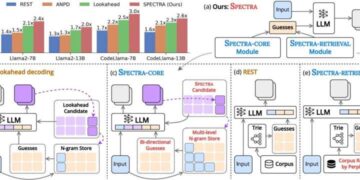Deploying a Machine Learning (ML) model means transferring a model that has been created and validated in a testing setting to a live production environment, where it can be applied to generate real-time decisions or forecasts.
Quickening this transition is essential for organizations aiming to use ML models to secure a competitive advantage swiftly. MLOps tools are crafted to simplify and speed up the process of deploying ML models. This piece will delve into the ways MLOps tools facilitate the quick deployment of ML models, concentrating on their primary characteristics and advantages.
Key Features of MLOps Tools
MLOps tools are a bunch of software and methods designed to handle every step of machine learning, from creating models to putting them into use and keeping them up to date. They mix the best tricks from both machine learning and DevOps (which is all about building and running software). This way, they make sure that machine learning models can be put out there, looked after, and updated easily. These tools make it easier to do the same boring tasks over and over, keep track of data, deal with different versions of models, and make sure the models are strong and dependable.
1. Automated Model Deployment
A key advantage of MLOps tools is their capability to streamline the process of deploying machine learning models. Rather than having to manually transfer models from a testing phase to a live production setting, MLOps tools can manage this task effortlessly. This not only reduces the effort and time needed for model deployment, but also decreases the chance of human errors.
2. Version Control
MLOps tools provide version control for ML models, which means that different versions of a model can be tracked and managed effectively. This is important because models often need to be updated or rolled back to previous versions based on performance or changes in data. Version control ensures that the correct version of the model is used in production and helps maintain consistency.
3. Scalability
MLOps tools can handle large-scale ML deployments. Based on the demand for model predictions, they can scale up or down. This ensures that the deployment can handle varying loads without compromising performance.
4. Monitoring and Logging
Effective monitoring and logging are critical for maintaining the reliability and performance of ML models. MLOps tools provide features for tracking model performance, logging predictions, and identifying issues. This helps address any issues that arise quickly, and ensures that the model continues to perform well.
5. Continuous Integration and Continuous Deployment (CI/CD)
CI/CD practices are integral to MLOps. They involve continuously integrating new code changes and deploying them automatically. For ML models, this means that updates to the model or its components can be tested and deployed quickly, ensuring that improvements are delivered to users without delay.
6. Data Management
MLOps tools can also manage the data that is used for testing and training models. They provide capabilities for data versioning, data lineage, and data quality checks. Proper data management ensures that the models are trained on accurate and up-to-date data, which is essential for their performance.
7. Security and Compliance
Ensuring ML models’ security and their adherence to compliance regulations is crucial. MLOps tools offer features for managing access control, auditing, and ensuring that models meet security and compliance requirements. This helps in protecting sensitive data and adhering to legal standards.
Also read: Top 10 Real World Applications of Machine Learning
Benefits of Using MLOps Tools
MLOps tools streamline the deployment and monitoring of machine learning models, ensuring both scalability and consistency. They also help improve collaboration and automation, enhancing productivity and model performance throughout the machine learning lifecycle.
- Speed: MLOps tools significantly speed up the model deployment process. Automation and streamlined workflows cut down the time required to transition models from development to production. This enables organizations to deploy new models and updates more quickly, which is essential in fast-paced business environments.
- Efficiency: By automating repetitive tasks and managing the entire ML lifecycle, MLOps tools improve efficiency. Teams can focus on developing and improving models rather than dealing with manual deployment processes and administrative tasks.
- Reliability: MLOps tools enhance the reliability of ML model deployment. With features like automated testing, version control, and monitoring, organizations can ensure that models are deployed correctly and perform consistently. This reduces the risk of deployment failures and ensures that models deliver accurate predictions.
- Scalability: The ability to scale ML deployments is crucial for handling large volumes of data and high demand for predictions. MLOps tools provide the scalability needed to manage growing workloads, ensuring that models continue to perform well as demand increases.
- Collaboration: MLOps tools facilitate collaboration between data scientists, engineers, and operations teams. By providing a unified platform for managing models and their deployment, these tools improve communication and coordination among team members. This leads to more effective and efficient model deployment processes.
Best Practices for Implementing MLOps Tools
To maximize the benefits of MLOps tools and ensure a smooth implementation, it’s important to follow best practices. Here are some key practices to consider:
- Define Clear Objectives: Before implementing MLOps tools, clearly define the objectives you want to achieve. Whether it’s faster deployment, improved model performance, or better collaboration, having clear goals will guide the selection and implementation of MLOps tools.
- Choose the Right Tools: Evaluate different MLOps tools based on your organization’s needs. Consider factors such as ease of integration with existing systems, scalability, and the specific features offered. Tools should align with your ML workflows and support your overall objectives.
- Integrate with Existing Processes: MLOps tools should complement and integrate with your current processes and workflows. Ensure that they work well with your data management systems, development tools, and deployment infrastructure. Integration minimizes disruptions and helps in achieving a smooth transition.
- Invest in Training: Proper training for your team is crucial for the successful adoption of MLOps tools. Ensure that data scientists, engineers, and operations teams are well-trained in using the tools and understanding MLOps best practices. This will enhance their ability to leverage the tools effectively and improve deployment outcomes.
- Implement Robust Testing: Testing is a critical part of the MLOps process. Implement robust testing procedures for your models, including unit tests, integration tests, and performance tests. This helps identify and address issues before deployment, ensuring that models are reliable and perform as expected.
Conclusion
Accelerating ML model deployment with MLOps tools is essential for organizations that want to stay competitive and make the most of their ML investments. MLOps tools streamline the deployment process, enhance efficiency, and ensure that models are reliable and scalable. By leveraging these tools, organizations can deploy ML models more quickly, manage them effectively, and continuously improve their performance. As ML technology continues to evolve, adopting MLOps practices will be key to maintaining a competitive edge and achieving successful ML deployments.













